As an Amazon Associate I earn from qualifying purchases.
This roasted salsa recipe is my go-to when I’m cooking Mexican food in summertime.
Think about it: When you are making grilled skirt steak, or grilled flat iron steak, or hell, any version of carne asada or grilled chicken or fish or whatever, you have this whole production of setting up the grill — if you use charcoal or wood, which I always do these days.
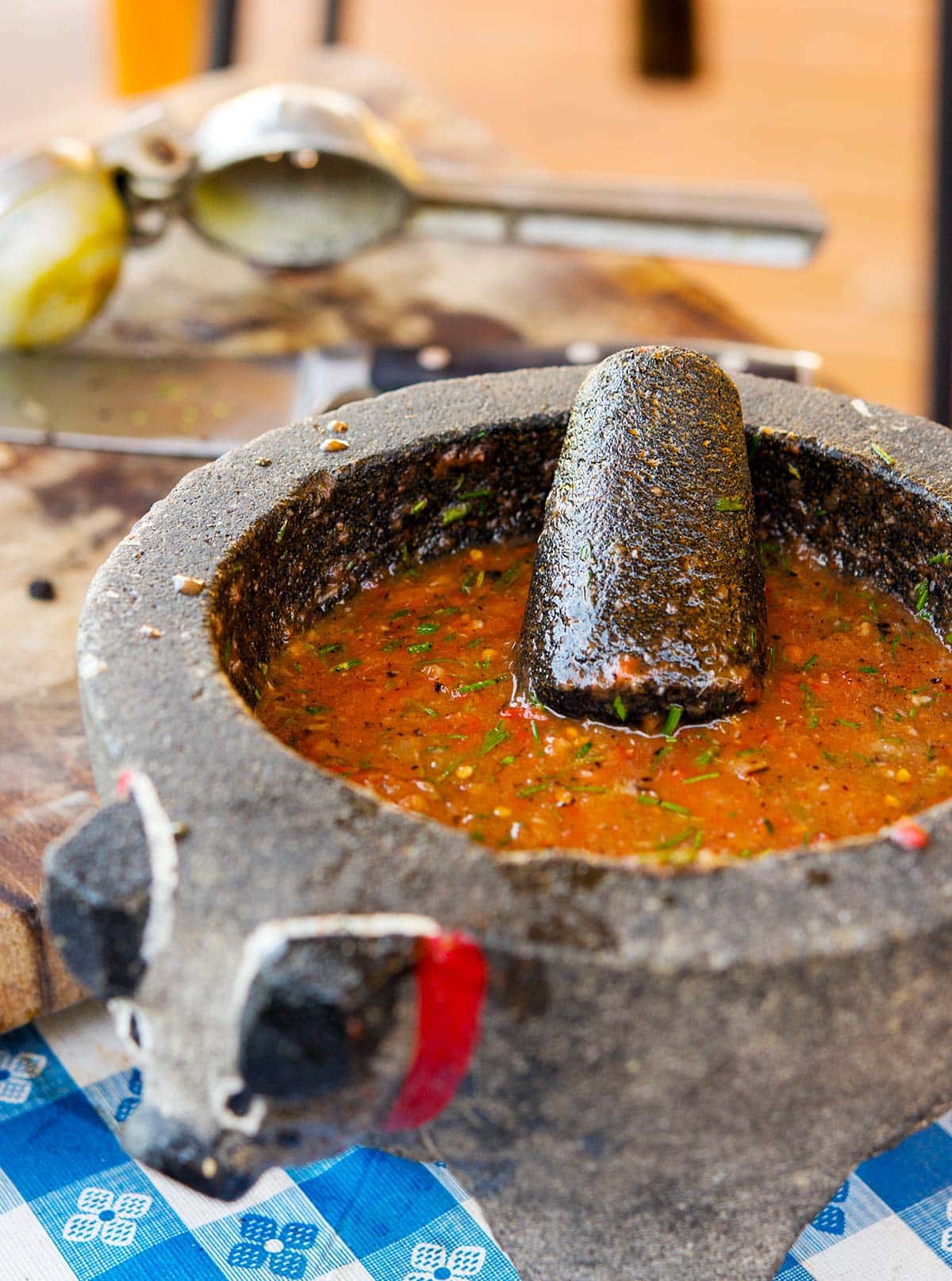
Many times what you’re grilling doesn’t take very long, so you are left with really good coals still plenty hot. Seems a shame to leave them.
The answer is to make fire roasted salsa. Specifically, make your roasted salsa before you put the meat on the grill. Since you know your coals will be fine, grill your tomatoes, chiles, onions and garlic first, make this salsa, then you can enjoy it with chips as your meat grills, and then put more on your tacos.
I like to grind my roasted salsa with a basalt mortar and pestle called a molcajete, which gives it a far better texture than if you blast it in a food processor or blender. But it’s fine in either.
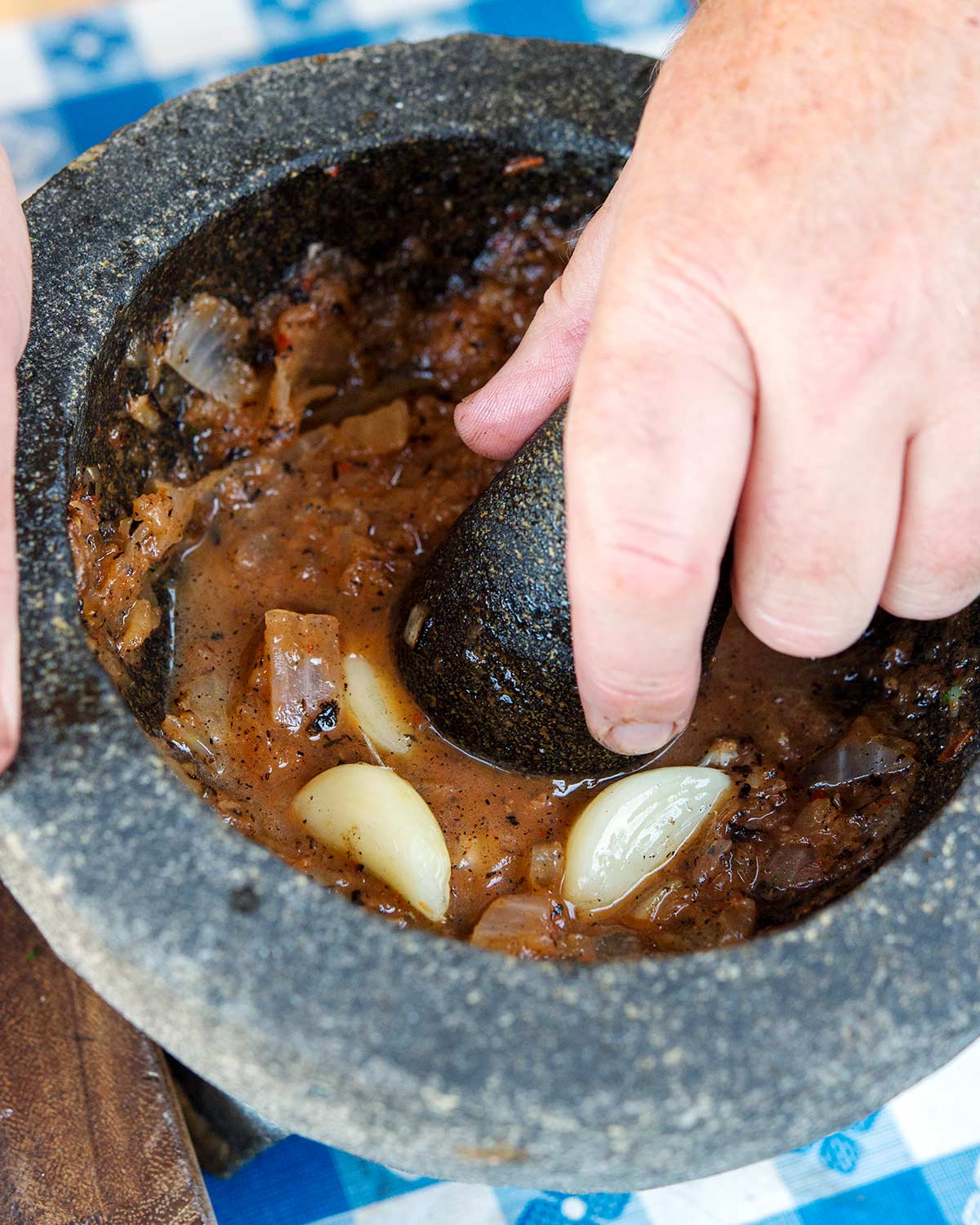
Roasted salsa is also fine if you have a gas grill, or no grill at all. You can make it in winter using your broiler, or a comal — a cast iron pan used in Mexico that’s like a frying pan with almost no sides. A cast iron frying pan works, too.
A few tips to make this roasted salsa recipe better than your friends’ versions:
- If you are using a grill, get the grates very hot and scrape them well. Food sticks to dirty grates…
- Use plum tomatoes, like Romas or San Marzanos. They grill or broil more easily than regular tomatoes. Also, if you have to buy crappy supermarket tomatoes, buy them several days before you make this salsa and sit them on the kitchen table. They will improve dramatically.
- Peel your tomatoes after grilling or searing. The peels should pull right off and they’re hard to digest, anyway.
- Keep your garlic in its skin. This gives you some protection from the searing heat. Also, put the garlic cloves around the edges of the grill or broiler.
- Always make sure you have some of the root attached to your quartered onion. This keeps the layers together. Also, if you are using a molcajete, chop your onions after they’ve been charred. You’ll thank me later.
- Set your charred chiles in a plastic produce bag to steam after you’ve blackened the skins. Then use the back of a knife to scrape off the skins. Do not rinse them with water, as this removes a ton of flavor. Use the knife to scrape away seeds.
- If you are using the molcajete for your roasted salsa, start the grinding process with salt and your garlic, then add onions, then chiles, then finally tomatoes and herbs. Always harder to grind stuff first!
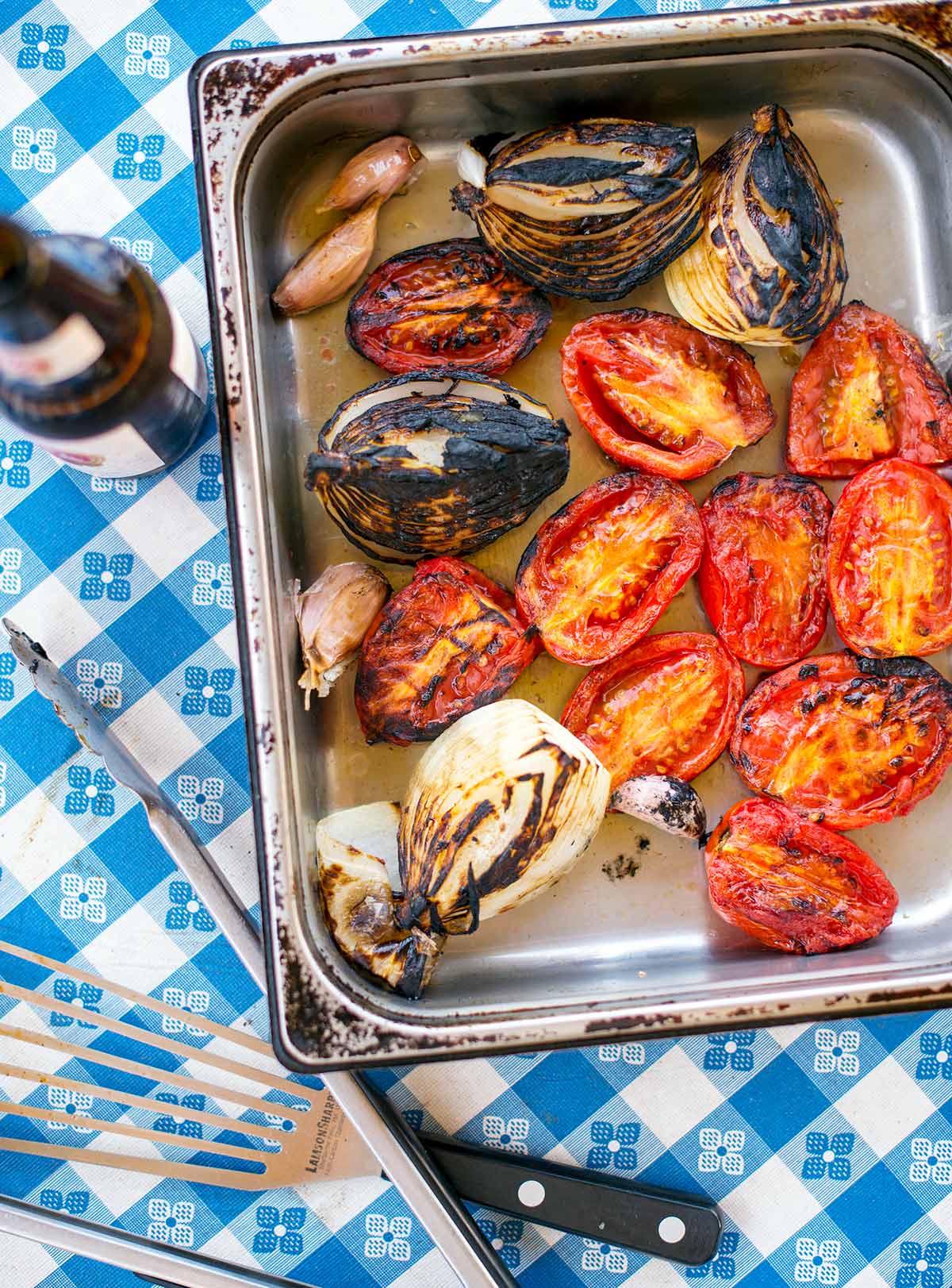
You have some options to play around with for a good roasted salsa. I mentioned the plum tomatoes, but I suppose others would work. For a green version, substitute tomatillos that have been husked and halved. White onions are traditional in most of Mexico, except for the Yucatan area, where they use red onions.
Your chiles should make you happy. I grow many odd varieties, and use whatever strikes my fancy that day. For the pictures, I used tiny chiltepins, which I did not char, but ground directly into salt to start the salsa. Most normal would be serrano, jalapeno or habanero chiles.
Add salt as you go. Start with the 1/2 teaspoon, then add a pinch here, a pinch there until it’s to your liking.
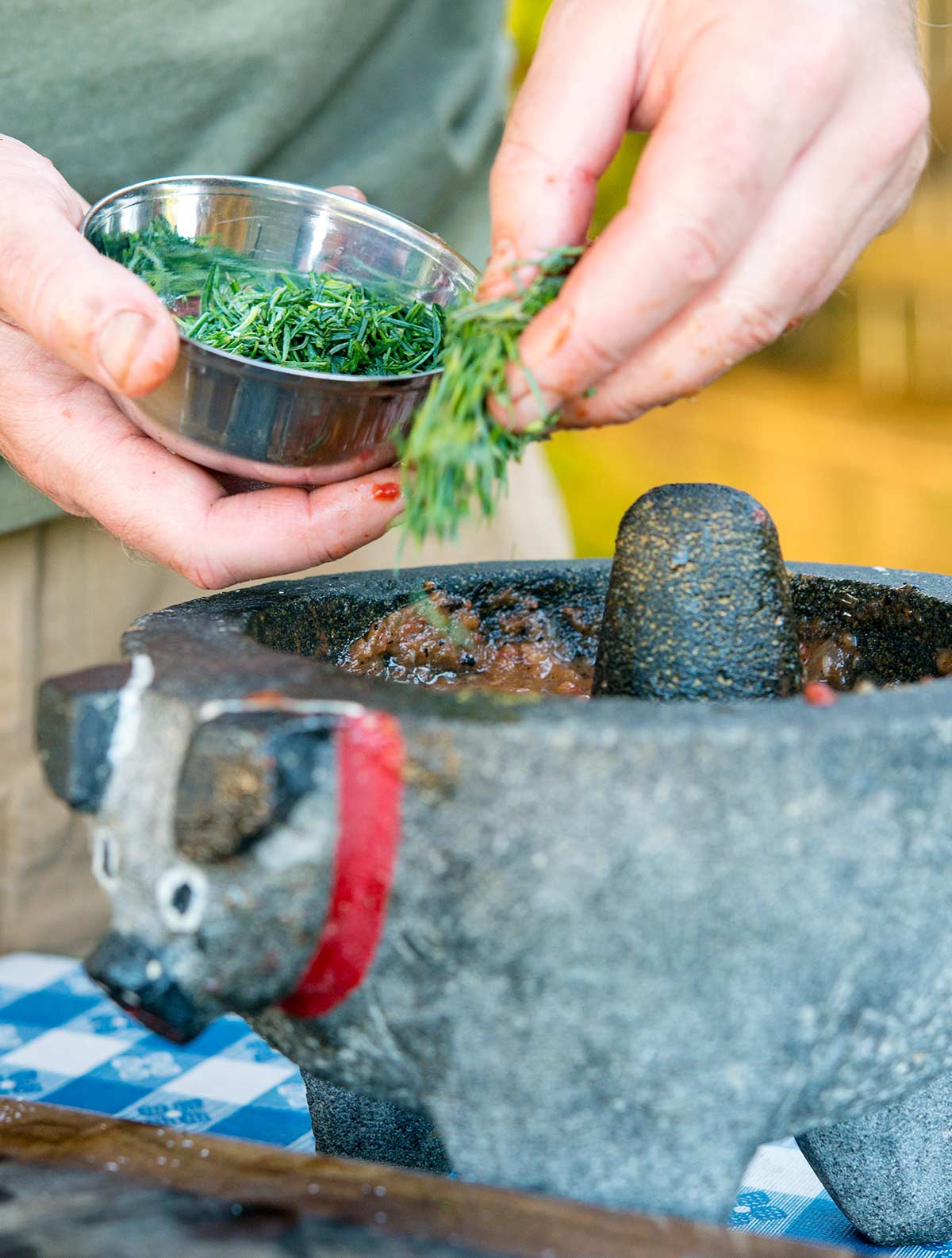
Finally a word on the herbal component. Not all roasted salsa has herbs in it, but mine always does. I will use whatever looks good in my garden: cilantro, pipicha, papalo, fresh Mexican oregano, even pitiona, which is an unusual herb from Oaxaca. For most people, cilantro is the ticket. Hate cilantro? Use chives.
If you can choose between a food processor and a blender, go with the food processor. Roasted salsa, or at least my version of it, should not be a smooth liquid. You want some texture.
Once made, your roasted salsa will keep a week or so in the fridge, and, if you add some citric acid to it, about a teaspoon per pint, you can water-bath can it for winter.
I make a lot of different salsas. You might like my Mexican salsa verde, or a salsa morita, which uses chipotles, or if you like things picante, my salsa de chile de arbol.
Fire Roasted Salsa
Ingredients
- 4 to 6 plum tomatoes, cut in half
- 1 or 2 white onions, cut in quarters
- 3 or 4 garlic cloves, unpeeled
- 1 to 4 serrano or jalapeno chiles (See note below)
- 1 teaspoon salt
- 1 teaspoon Mexican oregano (optional)
- 3 tablespoons chopped cilantro, pipicha, etc.
Instructions
- If you are grilling, get your grates hot and scrape them clean. Place your onions and tomatoes cut side down on the grill. Place the chiles and garlic cloves on the grill, too. If you are broiling, arrange everything on a baking sheet, cut side up.
- Let the onions and tomatoes grill a solid 5 minutes before trying to move them. You want significant blackening. Turn the garlic cloves as the peel blackens, and rotate the chiles so their skins blacken. Remove the garlic when several sides of the cloves have some char, when the skins of the chiles are well blackened, when both cut sides of the onion quarters are charred, and when the cut face of the tomatoes are well blackened. You will want to use a thin metal spatula to do this. If you are broiling, simply wait until you get good char on most of the vegetables.
- Put the chiles into a plastic bag to steam. Chop the onion roughly. Peel the garlic and if the cloves are large, chop into a few pieces. Remove the skins from the tomatoes. After 10 minutes or so, peel the chiles with the back of a butter knife, then open them up and scrape away their seeds. Chop them roughly.
- If you are grinding your salsa in a molcajete, add the salt, oregano and garlic and pound to a paste. Add the onion bit by bit, grinding and pounding all the way. Next comes the chiles, then the tomatoes. Finally, grind in the chopped herbs into the salsa. If you are not using a molcajete, simply put everything into a food processor and blitz it a few times. You want this salsa to have some texture. Add salt if you need it, and you are good to go.
Notes
Nutrition
Nutrition information is automatically calculated, so should only be used as an approximation.

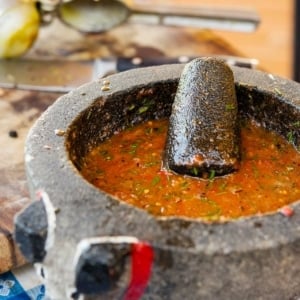
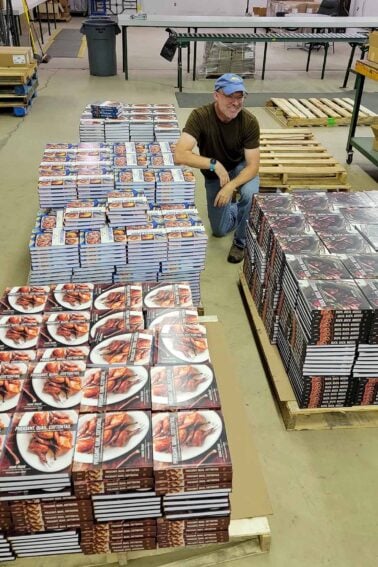

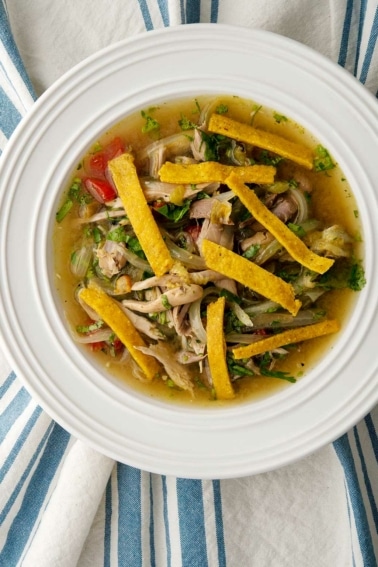
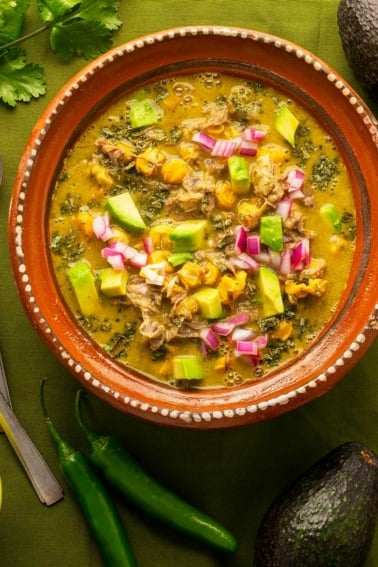
If I peel everything wouldn’t that take away from the fire roasted flavors?
I was thinking the same thing. Isn’t that the point of fire roasting it to get the flavor of the char into the salsa? Maybe the flavor soaks into the veggies without adding the char? I don’t know. I’m knew to making my own salsa.
Tina: When you clean the vegetables, yes, they get a smoky flavor, but you’re also never going to get all the char off when you peel, so there will be lots of flecks of charred goodness in there.
Hank, any idea how this freezes? Would love to preserve without adding extra acid…..
Mark: I’ve never tried it, sorry.
After years of making my tried and true salsa recipe I gave this a try for something different. A lot like the salsa verde recipe but with tomatoes and I’m here for it!
I also tried canning some, I’m almost certain I added some citric acid just to be safe and processed 30 min like I normally do with salsa. I cracked a jar a few weeks ago and it held up well
In the words stolen from an old hot breakfast cereal commercial (yes, I am old enough to remember the campaign and the brand of the cereal), “Good stuff, Maynard!” Easy to make. Though, I have taken to roasting a couple Limes cut in half and squeezing the juice into the salsa and adding some olive oil to help balance the acidity. A batch lasts maybe, say again, maybe two days before it’s all eaten.
10/10
Excellent way to use up the excess tomatoes coming out of my neighbor’s garden! Love the charred flavor in this. Only pain is seeding, skinning, and deveining the peppers.
Another fantastic recipe, Hank! Thanks for helping us make good, honest food that is easy and delicious! Used one jalapeño, seeded after roasting, and one serrano whole. Perfect balance with the smokiness and you have again knocked it out of the park.
Try it, y’all!!
Awesome stuff, Hank. Just made a double batch for a massive taco night with the family, it was a huge hit. I’ll need to add some spicier chiles next time to bump the heat a little, but it’s great even without the extra heat.
Just made double recipe today. Excellent!!
Just made this today! Easy and fabulous flavor.
Any recommendations on how I can safely can this in a water bath? I’ve got a large batch of tomatoes and peppers from the garden that need to be made into salsa!
Steven: Not entirely sure, but my guess it that you would need to add quite a bit of lime juice to make it acidic enough to can. Look up the National Center on Home Preservation for salsa canning.
Apple cider vinegar also works. You may need to add a little sugar to offset the vinegar.
We made this over out fire pit and it was delicious! We will definitely make it again.
This was a great recipe! We cooked all the ingredients over our fire pit so it was fun to make when you have friends over. Will definitely make it again.
Will make this tomorrow,I have some fresh picked red Thai chilies from our garden do you think they will work?
Low: Yep, they’ll work, but add them slowly or your salsa could get too spicy.
I think you meant put the chiles in a paper produce bag, Hank.
Chris: Nope. I mean plastic.
This is awsome with pequin! Thanks for the hint!!!
Hank, what size molcajete do you use?
John: The big one. I never knew there were particular sizes. I’ve only ever seen large ones like what I have, and teeny ones that are more for presentation.
I make something similar myself, but I put everything on the coals to get a good char and then I leave all that char in the salsa.
I notice though that I get a clear liquid pooling around the edges and in low spots after it sits for a while. I can’t figure out what it is. Any thoughts? I figure it is from the tomatoes, and I have gone so far as to let them sit and drain off, but the finished product always has it.
David: It’s just moisture from the vegetables. Stir the salsa to incorporate it before serving.
A chef’s recommended method of steaming the chilies after charring is to first put them on a plate, and then put an appropriately sized bowl over them. No bag needed 🙂
Years ago I had read one should use a paper bag and I didn’t always have one or had to really search to find one in the drawers. Now I just put a bowl over them and forget them till ready to process as needed.
Hank,
A killer Salsa recipe.
Thanks!
Tad